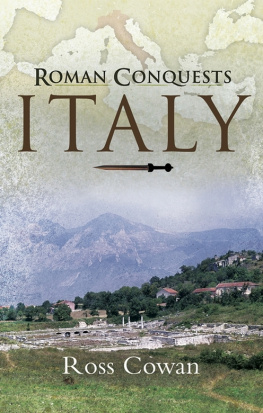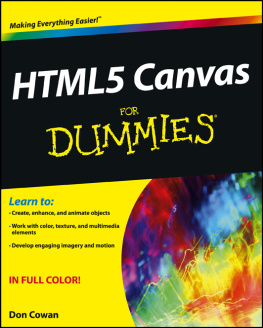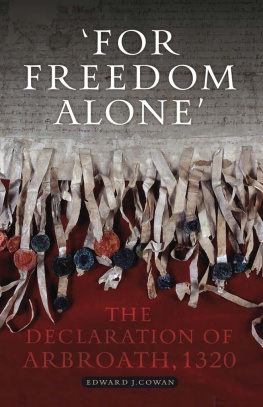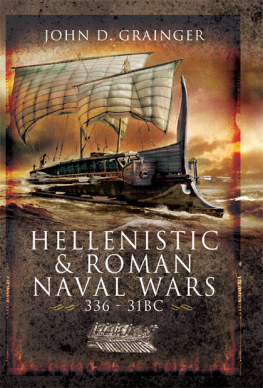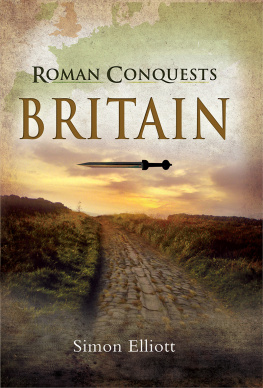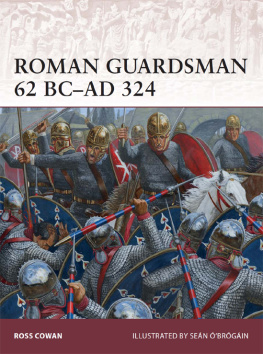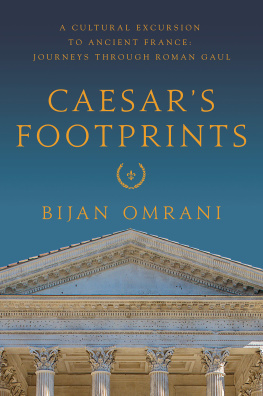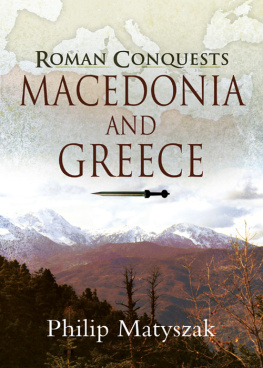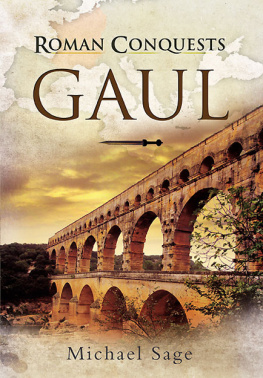The principal source, up to 292 BC, is Livy, books I X, and must be read in conjunction with the commentaries of Ogilvie (1965) and Oakley (1997 2005). For the supplementary ancient literary sources (Dionysius of Halicarnassus, Diodorus Siculus, Plutarch, Strabo, Appian, Dio, Zonaras, Pliny the Elder, Polybius, Florus, Frontinus, Valerius Maximus, et cetera) and epigraphic materials, consult Broughton (1951) and Degrassi (1947, 1957 1963), and see Oakley (1997 2005) for critical discussion. For sources specifically relating to the Roman army of the early and mid-Republican periods, see Sage (2008).
Modern Works
Affreschi Romani: Dalle Raccolte dellAntiquarium Comunale. Exhibition Catalogue (Rome: 1976).
Afzelius, A., Die rmische Eroberung Italiens (340 264 v. Chr.). (Copenhagen: 1942) reprinted in Afzelius, A., Two Studies in Roman Expansion (New York: 1975).
Alfdi, A., Early Rome and the Latins (Ann Arbor: 1965).
Bottini, A. (ed.), Armi. Gli Instrumenti della Guerra in Lucania (Bari: 1994).
Benassi, R., La Pittura dei Campani e dei Sanniti (Rome: 2001).
Bradley, G., Ancient Umbria: State, Culture, and Identity in Central Italy from the Iron Age to the Augustan Era (Oxford: 2000).
Brauer, G.C., Taras: Its History and Coinage (New York: 1986).
Briquel, D., Le tombe Andriuolo 114 de Paestum, in Briquel and Thuillier (2001), pp. 135 46.
Briquel, D. and Thuillier, J.P. (eds), Le Censeur et les Samnites: Sur Tite-Live, livre IX (Paris: 2001).
Broughton, T.R.S., The Magistrates of the Roman Republic, Volume I, 509 BC 100 BC (New York: 1951).
Brunt, P., Italian Manpower, 225 BC AD 14, revised edition (Oxford: 1987).
Capini, S. and Di Nero, A. (eds), Samnium: Archeologia del Molise (Rome: 1991).
Carelli, F., Numorum Italiae Veteris (Leipzig: 1850).
Cianfarani, V., Franchi dellOrto, L. and La Regina, A., Culture Adriatiche Antiche di Abruzzo e di Molise (Rome: 1978).
Cornell, T.J., Book VI of Ennius Annals: A Reply. Classical Quarterly 37 (1987), pp. 514 16.
Cornell, T.J., Rome and Latium to 390 BC, The Recovery of Rome and The Conquest of Italy in Walbank (1989), pp. 243 419.
Cornell, T.J., The Beginnings of Rome: Italy and Rome from the Bronze Age to the Punic Wars (c. 1000 264 BC), (London and New York: 1995).
Cowan, R.H., The Clashing of Weapons and Silent Advances in Roman Battles, Historia 56 (2007), pp. 114 17.
Cowan, R.H., An Important Italic Helmet Rediscovered, Archologisches Korrespondenzblatt 37(3) (2007), pp. 379 87.
Crawford, M.H., Roman Republican Coinage (Cambridge: 1974).
Curti, E., Dench, E. and Patterson, J.R., The Archaeology of Central and Southern Roman Italy: Recent Trends and Approaches, Journal of Roman Studies 86 (1996), pp. 170 89.
DAgostino, B., Military Organisation and Social Structure in Archaic Etruria, in Murray, O. and Price, S. (eds), The Greek City: From Homer to Alexander (Oxford: 1990), pp. 59 82.
De Franciscis, A., Stato e Societ in Locri Epizefiri (Larchivio dellOlimpieion locrese), (Naples: 1972).
Degrassi, A., Inscriptiones Italiae, volume XIII, fasicule 1: Fasti Consulares et Triumphales (Rome: 1947).
Degrassi, A., Inscriptiones Latinae Liberae Rei Publicae. Two volumes. (Florence: 1957 63).
Dench, E., From Barbarians to New Men: Greek, Roman and Modern Perceptions of Peoples of the Central Apennines (Oxford: 1995).
Dennis, G., The Cities and Cemeteries of Etruria (London: 1848).
Eroi e Regines: Piceni Popolo dEuropa. Exhibition catalogue (Rome: 2001).
Flower, H., The Significance of an Inscribed Breastplate Captured at Falerii in 241 BC, Journal of Roman Archaeology 11 (1998), pp. 224 32.
Forsythe, G., A Critical History of Early Rome: From Prehistory to the First Punic War (Berkeley and Los Angeles: 2005).
Franke, P.R., Pyrrhus in Walbank (1989), pp. 456 85.
Frederiksen, M., Campania (London: 1984).
Fronda, M.P., Livy 9.20 and Early Roman Imperialism in Apulia, Historia 55 (2006), pp. 397 417.
Gabrielli, C., Lucius Postumius Megellus at Gabii: A New Fragment of Livy, Classical Quarterly 53 (2003), pp. 247 59.
Garoufalias, P., Pyrrhus: King of Epirus (London: 1979).
Griffith, G.T., The Mercenaries of the Hellenistic World (Cambridge: 1935).
Guzzo, P.G., The Encounter with the Bruttii, in Pugliese, G.P. (ed.), The Greek World: Art and Civilization in Magna Graeca and Sicily (New York: 1996), pp. 559 62.
Hammond, N.G.L., Epirus: The Geography, the Ancient Remains, the History and the Topography of Epirus and Adjacent Areas (Oxford: 1967).
Harris, W.V., Rome in Etruria and Umbria (Oxford: 1971).
Harris, W.V., War and Imperialism in Republican Rome, 327 70 BC, revised edition (Oxford: 1985).
Harris, W.V., Roman Warfare in the Economic and Social Context of the 4th Century B.C., in Eder, W. (ed.), Staat und Staatlichkeit in der frhen rmischen Republik (Stuttgart: 1990), pp. 494 510.
Holland, L.A., The Purpose of the Capestrano Warrior, American Journal of Archaeology 60 (1956), pp. 243 7.
Hleskamp, K.-J., Conquest, Competition and Consensus: Roman Expansion in Italy and the Rise of the Nobilitas, Historia 42 (1993), pp. 12 39.
Kajanto, I., The Latin Cognomina (Helenski: 1965).
Keppie, L., The Making of the Roman Army: From Republic to Empire (London: 1984).
Kruta, W. (ed.), The Celts (Milan: 1991).
Leveque, P., Pyrrhos (Paris: 1957).
Lomas, K., Rome and the Western Greeks, 350 BC AD 200: Conquest and Acculturation in Southern Italy (London and New York: 1993).
McCall, J.B., The Cavalry of the Roman Republic: Cavalry Combat and Elite Motivations in the Middle and Late Republic (London and New York: 2002).
Malden, H.E., Pyrrhus in Italy, Journal of Philology 10 (1882), pp. 172 7.
Maule, Q.F. and Smith, H.R.W., Votive Religion at Caere: Prolegomena (Berkeley and Los Angeles: 1959).
Momigliano, A., The Origins of Rome, in Walbank (1989), pp. 52 112.
Naso, A., I Piceni. Storia e Archeologia delle Marche in Epoca Preromana (Milan: 2000).
Oakley, S.P., Single Combat in the Roman Republic, Classical Quarterly 35 (1985), pp. 392 410.
Oakley, S.P., The Hill Forts of the Samnites (Rome: 1995).
Oakely, S.P., A Commentary on Livy, Books VI X. Four volumes (Oxford: 1997 2005).
Ogilvie, R.M., A Commentary on Livy. Books 1 5 (Oxford: 1965).
Pontrandolfo, A. and Rouveret, A., Le Tombe Dipinte di Paestum (Modena: 1992).
Pontrandolfo, A., Rouveret, A. and Ciprano, M., The Painted Tombs of Paestum (Paestum: 2004).
Potter, D., The Roman Army and Navy, in Flower, H.I. (ed.), The Cambridge Companion to the Roman Republic (Cambridge: 2004), pp. 66 88.
Purcell, N., South Italy in the Fourth Century BC, in Lewis, D.M. et al. (eds), The Cambridge Ancient History, Volume 6: The Fourth Century BC. Second edition (Cambridge: 1994), pp. 381 403.
Putzger, F.W., Putzgers Historischer Schul-Atlas zur Alten, Mittleren und Neuen Geschichte (Leipzig: 1905).
Rawlings, L., Condottieri and Clansmen: Early Italian Raiding, Warfare and the State, in Hopwood, K. (ed.), Organised Crime in Antiquity (Cardiff: 1999), pp. 97 127.

